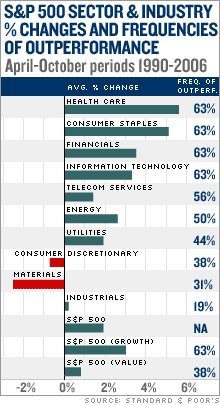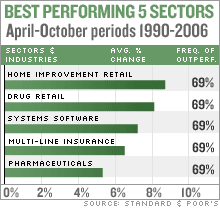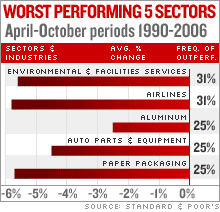|
Playing the 'worst 6 months'
Classic 'Sell in May and walk away' advice may prove useful in 2006. But if you're going to stay...
NEW YORK (CNNMoney.com) - "Sell in May and walk away" is an old Wall Street saying about the summer and early fall. But it's not all bad news in that often tough six months of the year. Some areas of the market actually do well.
Consumer and healthcare stocks tend to perform better than the broader S&P 500 historically, as investors focus on more defensive plays during tougher times, said Sam Stovall, Standard & Poor's chief investment strategist. Techs tend to surge in June, according to the Stock Trader's Almanac, while July starts a seasonally bullish period for biotech, gold and silver and utilities. Gas prices tend to rise during the summer driving and hurricane seasons -- bad news for consumers, but good for natural gas stocks. (For details on the best performing sectors in this period, see the chart). And hey, there's always bonds - corporate bonds, bond mutual funds, bond exchange traded funds. Not to mention cash. Or just keeping your stock and fund holdings pretty much as they are and not making any big changes in the period. "Your long-term holdings you leave alone, but your shorter-term ones you may want to move," said Jeffrey Hirsch, editor of Stock Trader's Almanac. That's because investors are about to delve into what is typically a tough six months. And although past performance certainly doesn't determine future results, there are plenty of reasons to suggest that this year will follow the pattern. The bull market is aging, oil is near record highs, gas is surging, interest rates are up, and the major gauges are at multi-year highs - all of which suggests a selloff may be looming. Plus, so far, the stock market has lived up to the "best six months" part, Hirsch noted. Between Oct. 31, 2005 and Wednesday's close, the Dow has gained 8.8 percent, versus the historic average of a 7.9 percent advance in that period. Most signs point to stocks living up to the "worst six months" too. Why "sell in May"?
As "sell in May and walk away" suggests, stock gains have been historically stronger in the November through April period than in the May through October period. The saying suggests that investors may want to move out of stocks into cash or fixed income in the tougher months and then back into stocks in November, at the start of the seasonally bullish period. The Almanac demonstrated this by looking at what would happen to a compounded $10,000 investment in the Dow Jones industrial average over the last 55 years. If the money was invested in the Dow in the "best six months" and then switched to fixed income in the "worst six months," it returned $489,933. If it was invested in the Dow during the "worst six" and moved to fixed income in the "best six," it lost $502. The period is tougher for a variety of reasons. Why? The positive effects of holiday bonuses and holiday retail sales have faded out by the second quarter, there are less capital inflows, and a spring cleaning mentality kicks in. By May, most of the first-quarter earnings have been reported and analysts are starting to reconsider their full-year forecasts. Once it gets to summer, "people tend to focus more on their tans than their portfolios," Stovall said. Granted, there are plenty of variations within that six month period. May is skittish, alternately very strong or very weak. The third quarter, comprising the months of July through September, tends to be the worst of the year. But individually, July isn't a bad month, often bringing a small summer rally. September, meanwhile, has been the worst month for the Dow and S&P 500 since 1950, according to the Almanac. October falls in the middle of the range - weak through most of the month, but then often ending up starting the advance that really takes off in November. -------------------------- Need a second-quarter road map? Click here. A tough six months are on tap. Click here.
A stock market storm is brewing. Click here. |
|



